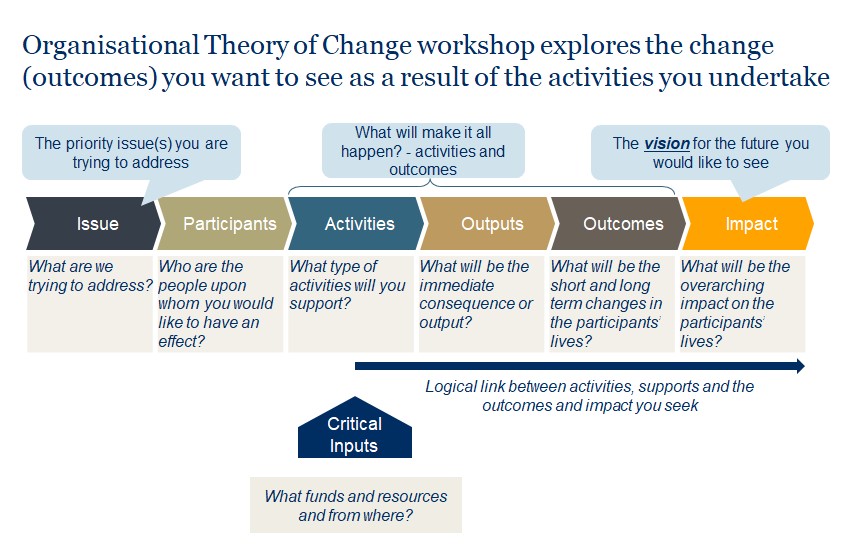Organisational Theory of Change improves community organisations and projects
Organisational Theory of Change improves community organisations and projects
Any organisation, particularly a community based organisation with projects designed to improve outcomes for children, teenagers, parents and educators needs a solid foundation in order to succeed in its goals. Unlike a house, community based organisations can’t rely on building that foundation and simply setting and forgetting and getting on with business. Sustained success in any societal focused organisation requires a culture of continuous improvement. Human beings aren’t a static commodity, scientific boundaries in the understanding of neurological functions are being constantly pushed and it is the organisations that stay ahead of the curve that provide the best outcomes for their clients.

The organisational theory of change has been developed and improved over the last few decades in order to give organisations the most up to date tools that allow them to change their models and processes to continually improve and deliver positive outcomes. Put simply, a theory of change is the framework that outlines the pathway to achieving specific goals. Much more than just a long range pie in the sky, a well designed theory of change outlines not only the organisational goals, but the activities, outputs, outcomes and investments required to make the desired impact.
What does a theory of change encompass?
There exist a number of organisational theories of change, but most find their basis in breaking down a number of core principles.
- The Issue
What is it your organisation is seeking to address? In order to understand the issue it is important for an organisation to be able to identify the issue within the specific context of its operations. Rather than looking at the issue through a problem lens, it is vital to be able to identify the strengths and opportunities available in solving the issue. For a program engaging in resilience building and social and emotional learning models, the issue may be the way trauma impacts a child’s brain functioning and the inhibiting of their ability to regulate their behaviours, connect with others and effectively learn.
- The Participants
These are the people upon whom you strive to make an impact on. If your goal is to build resilience in children by combating anxiety and depression, it is likely that their parents are high on the target group. Adults that interact with children experiencing trauma such as educators and service providers are also important participants in the journey to improving the resilience and educational outcomes of children.
- The Activities
What is going to make those above goals happen? These are the activities that you have identified as being important for succeeding in your goal. For high quality social and emotional based learning providers this is done through age-specific programs, workshops, seminars and mentoring - based on the neurosequential model for learning.
- The Outputs
This is where an organisation needs to be self-aware of their goals and place in the cycle of what they are trying to achieve. The outputs for a program can be described as the immediate consequences of implementing the activities above. Resilience building programs strive to increase awareness and knowledge about the impact of trauma on brain development and develop techniques which stimulate full brain functioning.
- The Outcomes
Think about the desired short and long term goals your organisation has for its participants. For resilience building programs for children, the desired outcome is adults and children adopting relevant techniques to improve children’s learning and social/emotional wellbeing.
- The Impact
This is deeper than the short term outcomes. The impact is centered around what you desire the overarching impact to be on the participant’s lives. If your vision is to have your program result in improved levels of educational attainment and social/emotional health of children who have experienced trauma, this is the impact.

The real work starts once the theory of change is implemented
A well designed, implemented and tracked theory of change is beneficial to multiple facets of an organisation. It is important to remember that it is just that, a theory. Without the full backing and adherence of relevant staff and stakeholders, it cannot be successful. It is also vital to ensure your theory model is adaptive to your industry variables. You will need to build in a system of feedback and information sharing between all stakeholders in order to identify any areas of improvement after implementation; simply ticking boxes isn’t going to cut it.
With all of these components in place you now have a stronger foundation on which to build your Theory of Change. You are much better equipped to make informed judgments about the approach you believe will achieve the impact you desire. It will also help you to share the vision of the impact you want to achieve to both internal and external stakeholders.
Pathways to Resilience use and action the Theory of Change to continually improve and refine the goals, objectives and outcomes of its organisation.
Click Pathways to Resilience Organisational Theory of Change to see how we have successfully implemented it for our programs.

